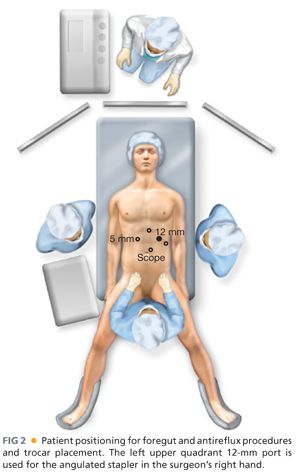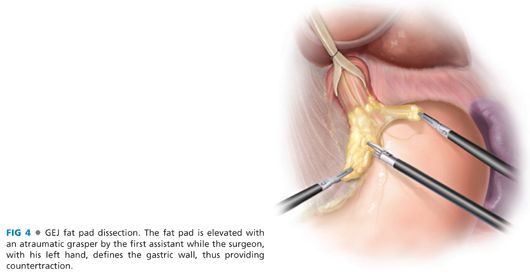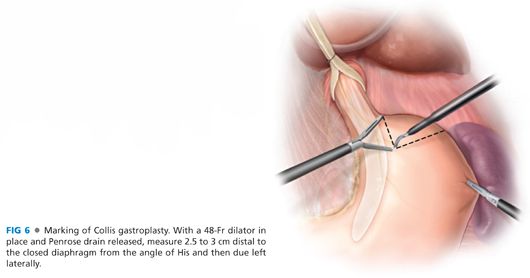■ Esophagitis, Barrett’s changes, and/or stricture
SURGICAL MANAGEMENT
Preoperative Planning
■ Because the Collis gastroplasty is an adjunctive procedure during gastric fundoplication, the principles of a proper antireflux procedure (wrap) or gastropexy apply, including left and right crural exposure, adequate mediastinal dissection, atraumatic esophageal retraction, and division of the short gastric vessels. Please refer to Chapters 1 and 5 for further details.
■ All studies, including esophagram, EGD, manometry, and pH testing should be readily available and reviewed prior to and at the time of surgery. The esophagram should be displayed on a spare or dedicated monitor in the operating theater and EGD images be loaded as well for intraoperative reference.
■ Attention to fine detail of the manometric report may avoid an unnecessary and detrimental 360-degree fundoplication, as a complete wrap may worsen symptoms in the light of the following findings7:
■ Severe esophageal dysmotility
■ Very low residual postrelaxation lower esophageal sphincter (LES) pressures less than 30 mmHg during wet swallow
Positioning
■ Although there are many port placement techniques, the stapled Collis gastroplasty necessitates a left upper quadrant, endoscopic, angulating stapler by the surgeon’s right hand through a 12-mm trocar. Steep reverse Trendelenburg is the position of choice (FIG 2).

■ Assume extensive mediastinal dissection will be warranted, and therefore, risk of pleural compromise (FIG 3). The sterile skin preparation must be wide enough on either flank in case tube thoracostomies are necessary from resultant pneumothorax. However, a red rubber catheter between 10 and 14 Fr may be placed in a witnessed pleural defect intraabdominally spanning the diaphragm to the hemithorax in question. This reduces the resultant pneumothorax and peak ventilatory pressures with the aid of lowering insufflation pressures as well as anesthesia-assisted ventilatory Valsalva.

TECHNIQUES
MEASUREMENT OF GASTROPLASTY
■ As mentioned in the “Positioning” section, this is an adjunctive maneuver, and thus, as previously described, adequate mediastinal, hiatal, and perigastric dissection should have already taken place.
■ Dissect the fat pad from the GEJ to expose the trajectories of stapler firing (FIG 4).

■ Remove any orogastric, nasogastric, or bougie first to recreate the nascent relaxed anatomy of the GEJ. From a posterior gastric approach, pull the left crus to the right, approximating it with the right crus. This demonstrates the relaxed position of the crura upon closure of the hiatus.
■ With an open, premeasured grasper, the intraabdominal length for the gastroplasty is then estimated (FIG 5). A distance from the anterior hiatus to the GEJ of less than 2.5 to 3 cm warrants the Collis gastroplasty. Measure from the relaxed hiatus 3 cm distally along a trajectory past the GEJ, if a bougie were inserted endoluminally, and 1 cm laterally. Here, mark with electrocautery the placement of the first perpendicular staple firing.

INTRAABDOMINAL RETRACTION AND BOUGIE PLACEMENT
■ A 48-Fr dilator is placed transorally up to 55 cm from the incisors (FIG 6). This serves as the stent about which the Collis gastroplasty is performed. The surgeon’s left hand retracts the cardia toward the patient’s left shoulder while the assistant retracts the greater curve laterally to the left flank.

FIRST STAPLE TRAJECTORY
■ The first stapled trajectory is usually performed with one or two firings of a rotating and articulating endoscopic stapler with medium-sized loads (3 to 4 mm) using a 45-mm length Endo GIA purple load (Covidien, Mansfield, MA). With the endoscopic stapler articulated to the maximum degree in the surgeon’s right hand, a 90-degree stapling is performed up to the body of the dilator on the left side of the patient just distal to the point predetermined and marked with electrocautery (FIG 7A–C).

Stay updated, free articles. Join our Telegram channel

Full access? Get Clinical Tree


